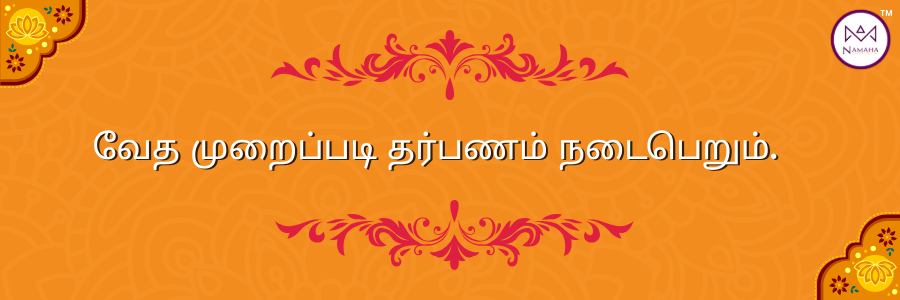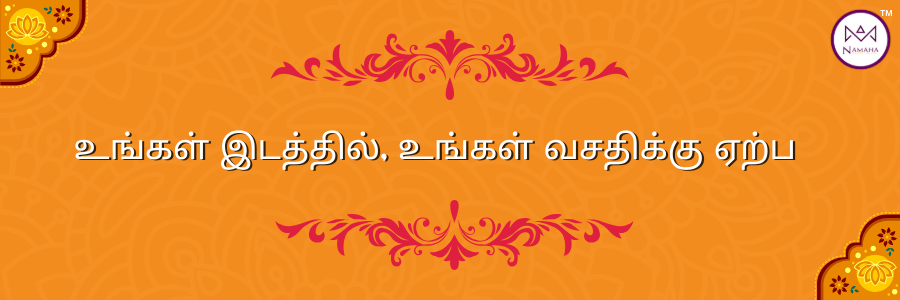
உங்கள் பித்ருதேவதைகளை கௌரவிக்கவும்
நமஹாவின் Online தர்ப்பணம் பேக்கிஜ்
புரட்டாசி அமாவாசை அன்று, தரமான வாத்தியார்கள் மூலம் தர்பணம் செய்து, நமது முன்னோர்களின் ஆசிகளைப் பெறுவோம். வாருங்கள், இந்த புனிதமான நாளில் ஒன்றிணைந்து பித்ருக் கடனை நிறைவேற்றி, நமது மூதாதையர்களுக்கு மரியாதை செலுத்துவோம்.
Supported By

Namaha என்பது மத்திய அரசின் கீழ் இயங்கும் DPIIT Startup India-வால் அங்கீகரிக்கப்பட்ட, இந்தியாவின் முதல் ஆன்மிக தொழில்நுட்பத் தளமாகும்.
தர்ப்பணம் செய்ய ஒரு செரியான வாத்தியாரை கண்டுபிடிப்பதில் சிரமம் உள்ளதா!?
முன்னோர்களை போற்றும் விதமாக அமாவாசை தர்ப்பணம் செய்வது நமது கடமை. ஆனால், இன்றைய வேலைப்பளு மிக்க சூழலிலும், தர்ப்பணம் பற்றிய போதிய அறிவில்லாமையாலும் இந்தக் கடமையைச் செய்ய நாம் சிரமப்படுகிறோம்


No More Confusion, Only Devotion
நமஹா-வின் Online புரட்டாசி தர்ப்பணம் உங்களுக்கு உதவுகிறது
எல்லா அமாவாசைகளிலும் சரியான முறையில் தர்ப்பணம் செய்வதை உறுதிசெய்ய, மிகச் சிறந்த தரமான வாத்தியார்களின் நேரடி வழிகாட்டுதலைப் பெறுங்கள்.
Online புரட்டாசி தர்ப்பணத்தின் பயன்கள்
Offline முறையில் எதிர்கொள்ளும் சவால்கள்
சந்திப்புகளுக்காக காத்திருப்பதும், வாதியார்களைத் தேடி அலைவதும்.
அமாவாசை தர்ப்பணத்திற்காக குறைந்தபட்சம் ₹2000 செலவு செய்வது.
அமாவாசை தர்ப்பணம் செய்யும் போது தவறு செய்து விடுவோமோ என்ற பயம்.
நமஹாவின் Online பேக்கிஜ் மூலம்
இருந்த இடத்தில், உங்கள் வசதிக்கு ஏற்ப தர்ப்பணம் செய்யலாம்.
தர்ப்பணம் செய்ய வெறும் 550 ரூ மட்டுமே
அனுபவமிக்க வாத்தியார் உங்களை வழிநடத்துவார்கள்.
#PerformTharpanam
With Namaha
*Puratasi Tharpanam happening on September 21.

We have created this Package that would be the perfect fit for you!
Online Puratasi Tharpanam Feedback
Hear what our Community has to say about us.
Ramesh Iyengar - Chennai

"Namaha Tharpanam helped me to perform Tharpanam at comfortable timing. Very satisfied with Vathiyar Quality and Customer Service "
Rishi Sheshadri - USA

"Satisfied to perform Tharpanam and stay connected with our traditions. Would reccomend to everybody."
Shankara Narayanan - Bangalore

"Happy to perform my Amavasya Tharpanam in authentic way."
Get your Free Panchangam Updates!
Get all Panchangam and Spiritual updates delivered to you, Subscribe Now!
First Name
Last Name
Phone Number
Join our community on Whatsapp!
Frequently asked questions
Here are the most asked questions by our Customers.
Performing Tharpanam on every Amavasya (new moon day) is considered highly beneficial in Hinduism for several reasons:
Blessings of Ancestors: It is believed that on Amavasya, the departed ancestors are more receptive to the offerings made by their descendants. Performing Tharpanam can appease them and invoke their blessings for the well-being of the family.
Removal of Pitru Dosha: Pitru Dosha is a condition believed to arise from the unfulfilled desires or displeasure of ancestors. Regular Tharpanam, especially on Amavasya, is said to mitigate the negative effects of Pitru Dosha, which can affect various aspects of life like career, relationships, and finances.
Fulfillment of Desires: By satisfying the ancestors through Tharpanam, it is believed that they, in turn, bless their descendants with the fulfillment of their righteous desires, including improvements in income, health, and marital harmony.
Family Prosperity and Harmony: Tharpanam is thought to foster harmony and understanding within the family. Satisfied ancestors are believed to bless the family with prosperity, success, and balance.
Mental Peace and Healing: Unresolved ancestral issues can sometimes lead to emotional disturbances. Performing Tharpanam can provide mental peace and healing by resolving these underlying issues.
Blessings for Future Generations: The positive energy and blessings received from the ancestors through Tharpanam are also believed to benefit future generations, protecting them from negative influences and guiding them towards a bright future.
Spiritual Progress: Tharpanam is considered a part of "Pitru Yagya," a way to honor and repay the debt to our ancestors, contributing to our spiritual growth.
Protection from Negative Forces: Some believe that performing Tharpanam can ward off negative energies and evil influences.
Here's a breakdown of when Pitru Tharpanam is typically performed:
1. Amavasya (New Moon Days):
Most Common: Pitru Tharpanam is primarily performed on every Amavasya (new moon) day of the Hindu lunar calendar. It's believed that on Amavasya, the Pitru Loka (ancestral realm) is more accessible, and offerings reach the ancestors easily.
Monthly Offering: Many people perform it monthly on the Amavasya Tithi to appease their ancestors regularly and seek their continued blessings for material prosperity and spiritual progress.
2. Pitru Paksha (Fortnight of Ancestors):
Most Significant: This 15-day period, usually in the Hindu month of Bhadrapada (September-October), is exclusively dedicated to honoring deceased ancestors. It is considered the most crucial time of the year for performing Shradh and Tharpanam rituals.
Mahalaya Amavasya: The last day of Pitru Paksha, known as Mahalaya Amavasya or Sarvapitra Moksha Amavasya, is highly significant. If someone is unable to perform Shraddha on all the specific Tithis during Pitru Paksha, performing it on Mahalaya Amavasya is believed to appease all deceased souls in the family. It's also the day to perform Shraddha for those whose death anniversary Tithi is unknown.
3. Other Auspicious Occasions:
Annual Shraddha (Death Anniversary): Pitru Tharpanam is an integral part of the annual Shraddha ceremony performed on the specific Tithi (lunar date) of the ancestor's demise.
Solar and Lunar Eclipses (Grahaṇa Tharpanam): Performing Tharpanam during eclipses is considered highly meritorious.
Sankranti: The beginning of certain Hindu months (Sankranti, especially Mesha, Karkidaga, Thula, and Makara Sankranti) are also considered auspicious for Tharpanam.
Daily Rituals (Brahma Yagna Tharpanam): Traditionally, a form of Tharpanam was part of daily rituals to Devas, Rishis, and Pitrus.
After Funeral Rites (Gunda Tharpanam): Performed in the first ten days after a death.
Day After Annual Shraddha (Parheni Tharpanam): Though often performed on the same day as the annual Shraddha now.
The common materials needed for performing Tharpanam include:
Mat or Asana: To sit on, preferably made of sacred Darbha grass (Kusha grass), a wooden plank, or a clean cloth of natural fibers.
Plate: Made of wood, copper, brass, or silver to place the offerings. Avoid glass and stainless steel.
Water: Clean water in a copper, brass, or silver cup for offering. You may also need extra water in a bowl.
Black Sesame Seeds (Til): Considered sacred for ancestral rituals.
Darbha Grass (Kusha Grass): Several strands are needed. A ring made of Darbha grass (Pavitram) is also worn on the ring finger of the right hand.
Raw Rice or White Rice Flour: May be mixed with sesame seeds for the offering.
Coin: A small coin (dime or nickel), or a gold coin if available, to be included in the offering. This can usually be reused after rinsing.
Sandalwood Powder: May be used to make a paste.
Flowers or Petals: For offering.
Optional:
Pindas: Rice balls, traditionally used in some regions.
Ghee: Clarified butter.
Lamp and Incense: To create a serene atmosphere.
Ganga Jal: Holy water for purification.
Paternal Lineage:Father (Pithru) Grandfather (Pithamaha) Great-Grandfather (Prapithamaha) Their respective wives (Mother, Grandmother, Great-Grandmother - Matha, Pithamahi, Prapithamahi)
Maternal Lineage:Maternal Grandfather (Mathamaha) Maternal Great-Grandfather (Mathuhu-Pithamaha) Maternal Great-Great-Grandfather (Mathuhu-Prapithamaha) Their respective wives (Maternal Grandmother, etc.)
If any of these ancestors are still living, they are not included in the Tharpanam. In some traditions, if an ancestor in the direct line is alive, you may extend to the next preceding generation.
Some traditions also include offerings to other relatives like uncles, aunts, siblings who have passed away. Additionally, "Karunya Tharpanam" might be performed for all departed beings, including plants and animals that have sustained us.
If you are going to perform Tharpanam after a long gap, the procedure remains essentially the same.
However, you may want to:
Re-establish the Connection: Mentally reconnect with your ancestors with sincerity and devotion. The intention and heartfelt offering are crucial.
No Specific "Missed" Rituals: There isn't usually a specific compensatory ritual for the missed Tharpanams. Just resume the practice with faith.
Consult Elders or Priests (Optional): If you feel particularly concerned or have specific doubts due to the long gap, you can consult knowledgeable elders in your family or a priest who can provide guidance based on your family traditions.
Regularize the Practice: Aim to perform Tharpanam regularly on Amavasya days going forward to maintain the connection with your ancestors and receive their continued blessings.
Focus on Sincerity: Whether it's after a long gap or a regular practice, perform the Tharpanam with sincerity, respect, and faith. The attitude and devotion are more important than just the ritualistic actions.
Copyrights 2023 | Namaha™ | All rights reserved |
support@namaha.ai | +91 7708246995

Recieve Daily Panchangam
Updates!
Get Daily updates on Thithi, Horai, Karanam, Kuligai, Nalla neram and a lot more from 2025 Vishavavasu Panchangam, delivered on Whatsapp.
We HATE spam. Your email address is 100% secure



